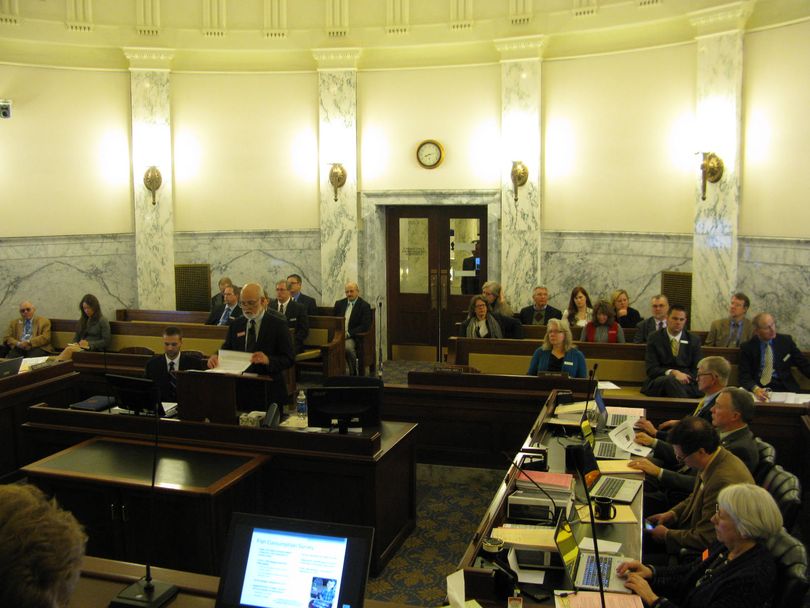DEQ budget doesn’t restore cuts, agency says it’s refocused and is keeping pace…

Idaho’s Department of Environmental Quality workforce has dropped significantly since 2010, when the DEQ had more than 380 employees, to a proposed 355 for next year. But the department’s not asking to boost that back up; instead, Director Curt Fransen’s budget request, presented to the Joint Finance-Appropriations Committee this morning, asks to formalize the lower staffing level by removing the now-unfunded positions.
“We are comfortable recommending that the base be reduced to more accurately reflect the … expenditure in 2015,” Fransen told JFAC. The department is asking for one new position next year to work on water quality standards, which Fransen said is his top priority; Gov. Butch Otter has recommended funding the position. “Our current workload in this area is significantly outpacing our resources,” Fransen said. The result could be Idaho losing control of the setting of its water quality standards to the EPA. “Sometimes we are not in control of our own destiny,” he said. “The work that we do in our water quality standards area seems to be driven by these lawsuits and these demands and changes in federal requirements. I would very much like to get ahead of that process. We are falling further and further behind.”
The governor’s proposal for DEQ for next year reflects a 2.2 percent increase in state general funds, but a 1.3 percent drop in overall funding; it calls for $15.2 million in general funds, $11.2 million in dedicated funds and $39.1 million in federal funds. Other than the one new position in water quality standards, the only enhancement in the budget request is to make the annual, one-time transfer of $1.5 million from the state’s water pollution control account to the Environmental Remediation Fund to provide the state’s 10 percent match for Coeur d’Alene Basin superfund cleanup.
Fransen said the cleanup of historic mining contamination in the basin is proceeding. Blood-lead levels in children in the Kellogg area were once among the highest ever recorded in the country; now, they’ve dropped to “levels consistent with national averages.” A stepped-up testing program this summer “confirmed that the blood-lead levels of children in the ‘box’ remain within national averages, and demonstrate that the cleanup efforts have been successful,” he said, “effectively maintaining the progress that has been made.”
Ongoing work there includes remedial protection, infrastructure improvement projects such as installing drains and culverts to protect the cleanup work already completed from localized flooding, and repairing damage to local roads caused by heavy truck traffic involved in cleanup. “The vast majority of past and future cleanup work in the Superfund has or will be provided by the federal government and mining company settlements,” Fransen told lawmakers.
When lawmakers questioned how DEQ is doing on getting permits processed with its lower staffing level, Fransen said, “We have focused our resources on our core activities, and getting permits out is one of our core activities. … We are currently maintaining the pace.”
He was also questioned about HB 406, the bill proposed by the Idaho Association of Commerce & Industry to have the state take over primacy from the EPA on wastewater permitting. “This is not DEQ’s legislation, and we do not have a position on this bill,” Fransen said. “We’re just trying to be helpful in terms of … here’s what the benefits are, here’s what the costs are.” The first-year cost estimated in the bill is $300,000 and three positions, as a multi-year takeover is envisioned that would stretch for seven or eight years; eventually, the program would cost an estimated $2.5 million a year. Fransen said that’s based on state studies that haven’t been updated since 2005, but said, “I think we’re in the ballpark.
Rep. Shirley Ringo, D-Moscow, asked about the waste repository near the Cataldo Mission. “When that was first put in place, a lot of individuals in the area were concerned, when higher water levels would come along, the pollutants might be washed on down. I’m wondering how you think that’s going, with your monitoring of any effects of that repository.”
Fransen said the repository has been in place for five or six years. “One of the reasons that that location made sense is that the area there is highly contaminated, there are contaminated sediments at that site,” he said. “That’s the area where the river loses velocity and a lot of the metals and the sediments fell out of the water column over the years. And there was actually a dredge in the area to pull those sediments out and spread them on the mission flats.” He said the materials going into the repository are less contaminated than the materials in the same area at greater depth. “It is lined. It will be lined on the top when it is completed,” Fransen said. “It’s constructed in a way that it sheds water, and water will not move through the repository. We have monitoring wells around the repository. … We do not show any increase in the contamination in the groundwater in that location.”
